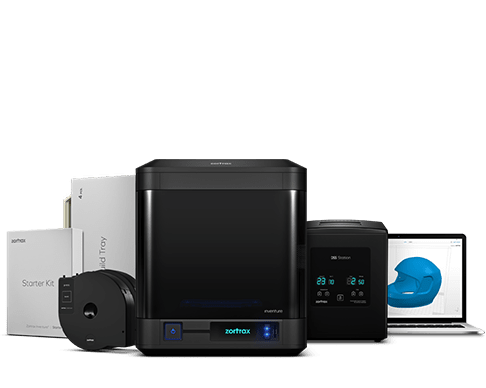Materials for 3D Printing. Why Quality Is a Key in 3D Printing?
The vast majority of persons setting out for their adventure with 3D printing pay attention mainly to the specs of the printer itself. They look up all kinds of information about its capabilities and design. Unfortunately, they aren’t as meticulous when it comes to selecting the material they will place in the 3D printer. This is a big mistake which can have an adverse effect on the quality of the final 3D print.
The Basics
First of all, let’s recall how 3D printing is conducted in the most popular LPD technology. During the process a thin cord of plastic material is moved into the print head by the extruder. The head, heated to a very high temperature, turns the cord into a semi-liquid. In this state the material can be placed easily in the selected place in the workspace and subsequent layers of the model can be 3D printed.

ZORTRAX Inventure
What’s crucial about the process is providing the head with a constant supply of material. The 3D printer has to know how much material exactly will enter the head at any given time. This is the flow rate, expressed as milliliters per second. However, this parameter is worthwhile only when the diameter of the filament is constant. Otherwise, different amounts of material will be introduced into the 3D printer in equal time slots and the calculated flow will have little in common with the actual flow.
If there’s not enough filament, the 3D print will have gaps and it will not get the intended shape. If there’s too much, the head will get clogged and 3D printing will stop. That is why the cross-section of the extruded material needs to be of constant shape and diameter. Otherwise, the material will not be spread evenly, which will harm the final shape of the item and may cause it to be very different from what was intended.
The shape of the filament is also important. Its movement in the extruder is controlled by a thumbscrew to which the filament is pressed. If the material is of a perfectly elliptical shape, the process will be conducted efficiently and without incident. If the cross-section changes, the material might get blocked in the extruder and the process stops.
Aim for the Top
Low quality filaments may be impure. In such a case unwanted dust will enter the print head and gradually clog it. Low quality filaments can also have air bubbles within them, which will also reduce the amount of filament actually introduced to the head. That is why you have to pay attention to the quality of the material. Usually it’s best not to buy the cheapest filaments from unknown companies: they will often have some (or even all) of these flaws.

ZORTRAX Z-ESD material
How to select the best filament? There are two options. One of them is the easy way out: to pick the material recommended for your 3D printer. For example, Zortrax offers both 3D printers and materials. These create a perfectly working ecosystems which will never fail its user.
Unfortunately, filaments by major companies tend to be expensive. Don’t be surprised: you have to pay for quality. However, for some the issue is not just about high quality, but also low price. If that’s the case for you, what you need to do is analyze filament tests in professional magazines. Reading or watching tests can take a lot of time, but it’s hands down the best way to find a filament which is both inexpensive and good. Otherwise you’ll have to learn from your own mistakes, which can be a painful experience.